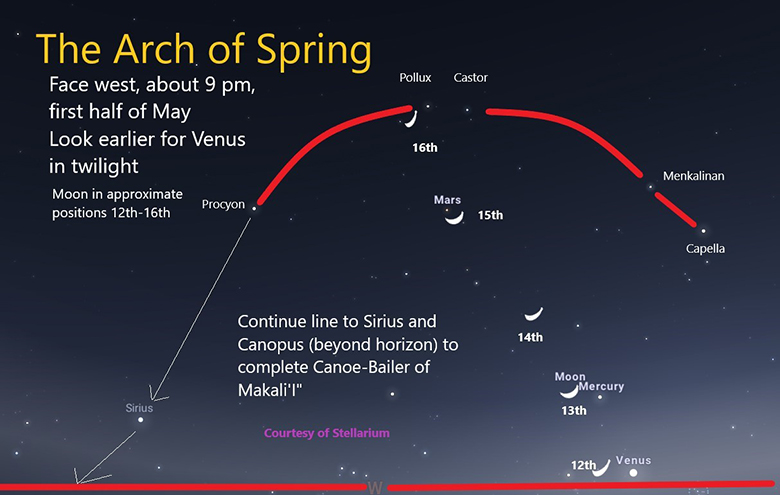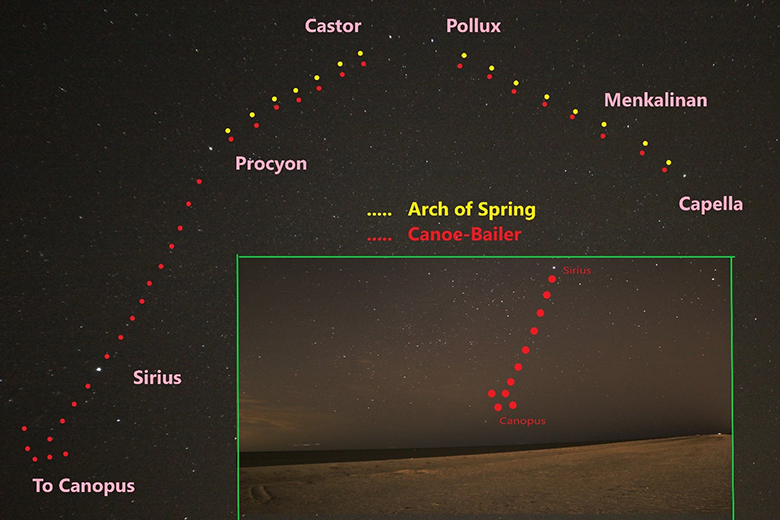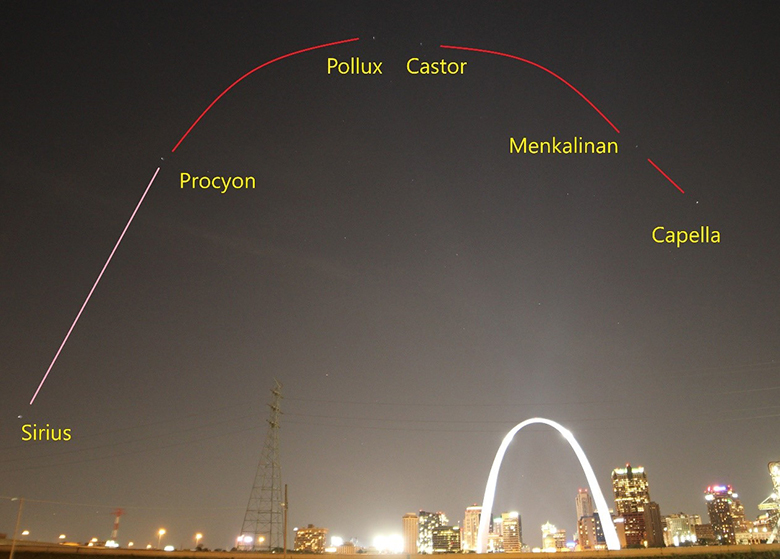The Arch of Spring

Image courtesy of Stellarium, with approximate Moon positions for May 12-16 added by our Sky Ranger. View approximately 9 pm in first half of May- look earlier to spot Venus very low in bright twilight.
At Gateway Arch National Park, of course we celebrate arches. They can be naturally occurring, like at Arches National Park or artificial, like at our Park or the nearby Eads Bridge. At least one time, a visitor has asked, apparently seriously, whether or not the Gateway Arch is natural. In my position as the Park’s Sky Ranger, I always jump at chances to combine themes together, and I am glad to report that there is an easily-seen arch in the sky. Although it is above the horizon at one time or another every day, spring is the best time to see this curving celestial curiosity, at a convenient hour of night.
To find the Arch of Spring, go out any clear night in May, soon after dark, and face west. By the end of May, the Arch will be low in the sky and you may need to find a spot with an open view. Two fairly bright stars, shining side by side, will grab your attention. These are the famous Gemini twins, Pollux on the left, and slightly fainter Castor on the right. If the sky is clear and dark enough or you use binoculars, it is possible to trace out the outline of two matchstick people extending down from the twin stars. Pollux is a relatively nearby star, just 34 light years from Earth. Look closely, and you might notice it has a very slight yellowish orange color. If you look at a lit candle, the hottest part of the flame, near the wick is blue, and then progressively the color changes from white to yellow to orange to almost red. Pollux thus has a similar temperature to our Sun- just slightly cooler. However, if our Sun were 34 light years away like Pollux, it would hardly be visible to the unaided eye, so Pollux is a much larger, giant star. The most noteworthy thing about Castor is that telescopes reveal that it is actually a six star system, with the stars close enough together that they all blend together into one as seen with the unaided eye.In mythology, Castor and Pollux had the same mother- Leda, wife of Tyndareus, King of Sparta. Although they were twins, they had two different fathers, as Leda was seduced by Zeus, King of the Gods. Pollux was the product of this union, while Castor was fathered by Tyndareus- thus Castor was mortal and Pollux divine. They had many adventures together, often as part of the crew of the ship Argo, which sailed the seas in search of the Golden Fleece.
The south leg of the Arch of Spring is formed by Procyon, the lesser Dog Star, to the left and somewhat below the Twins. The north leg is made up of the stars Menkalinan and Capella, to the lower right of the Twins. Put it all together and you have a pretty nice arch- definitely not a catenary curve like the Gateway Arch, but striking nonetheless.
The Arch of Spring covers a large area of sky, from northwest to west-southwest, so keep that in mind while searching for it. However, it is small compared to a vast star line, which was part of the sky lore of the Hawaiian and Polynesian peoples, the Canoe-Bailer of Makali’I”. The Canoe-Bailer is not entirely visible from the latitude of St. Louis, but can be seen in full from the southern United States and Hawaii. To see as much as possible, look early in the evening during the first part of May. Trace out the Arch of Spring and then look well to the lower left of Procyon. If you have an open enough view, you will spot Sirius, brightest star in the night sky, probably twinkling frantically through the thick atmosphere close to the southwestern horizon. Sirius is one of the nearest stars to our Sun, at a distance of 8.6 light years, explaining its high brightness. As seen in the picture, it is possible to imagine a huge net out of the stars of the arch and Sirius. This net has a handle, composed of the second brightest star in the sky, Canopus, located almost forty degrees south of Sirius. I have never mentioned Canopus before in this blog, for a reason- you can’t see it at the latitude of St. Louis. Earth’s axis is tipped just a little too far away from it. Canopus can be glimpsed from the Missouri bootheel or Tennessee, and stands out well from the southern U.S. or Hawaii. Its increasing visibility as one heads south was cited by Muslim astronomers as proof that the Earth is round. A few weeks ago, my family and I took a trip to South Florida, and I took the photo below. The entire Canoe-Bailer is too large to fit in one image, so I included an inset of Canopus, about to set, seen just above the horizon formed by the waters of the Gulf of Mexico.

The Arch of Spring and Canoe-Bailer of Makali’I” star groups as seen from Sanibel, Florida. NPS Photo/RF
The Hawaiian and Polynesian peoples have tended to include large groupings of stars into star lines that would assist them in navigating by sea. According to one story, Makali’I’ was an evil chief who stole all of the food accumulated by the people, and placed the food into the sky, suspended by a huge net. In order to save everyone, a tiny mouse ventured its way up to the net and gnawed a huge hole, allowing all of the food to fall back to Earth. In another story, Makali’I”, whose name means “eyes of the chief,” served as navigator for Chief Hawai’iloa, who by tradition was the discoverer of the Hawaiian islands. Makali’I” appears in the sky in the form of the Pleiades or Seven Sisters star cluster, which is all but lost in the sun’s glare. With binoculars, you might glimpse some of the stars of Makali’I” close to Mercury near May 3rd. The huge net holds water when the stars rise in the east and southeast during fall, and bails the water out in the spring, as can be seen here. Perhaps there was a leak in their huge canoe!
Three planets can be found in May’s evening skies. Mars, just a shadow of its brilliant self, is visible as the next fairly bright orange “star” below the Gemini twins in the early evening. It shines about a fortieth as bright as it did at closest approach to Earth last October. Look early in the evening, about a half hour after sunset, to spot Venus very low above the western horizon in bright twilight- must find a spot with an open view! In its best evening showing of 2021, Mercury can be found roughly the width of a fist above and slightly left of Venus, best around May 1-18. After that, the innermost planet presents more and more of its unlit side towards Earth as it passes more and more between the Earth and Sun, causing it to fade rapidly. If you have binoculars, try to continue following Mercury as it appears to approach Venus towards the end of the month- less than a Moon’s width apart on the night of the 28th. This is an illusion- Mercury will be almost between the Earth and the Sun while Venus is on the far side, so the two appear close but will be about 100,000,000 miles apart!

The Gateway Arch and the Arch of Spring as seen from the Malcom W. Martin Memorial Park, East St. Louis, IL. April 25, 2021 NPS Photo/RF
Join us for our first Gateway to the Stars program of 2021.NOIRLab Scientist Dr. Connie Walker will discuss “The Globe at Night”- a campaign in which citizen scientists can assists professionals by measuring the brightness of their night skies using nothing more than a smartphone or tablet. This will be followed by Virtual Stargazing at the Gateway Arch, featuring a guided tour of May’s night skies and live or recorded images of celestial objects. This program will take place May 8 from 8-9:30 pm. Go www.facebook.com/stlastro to access this program.
